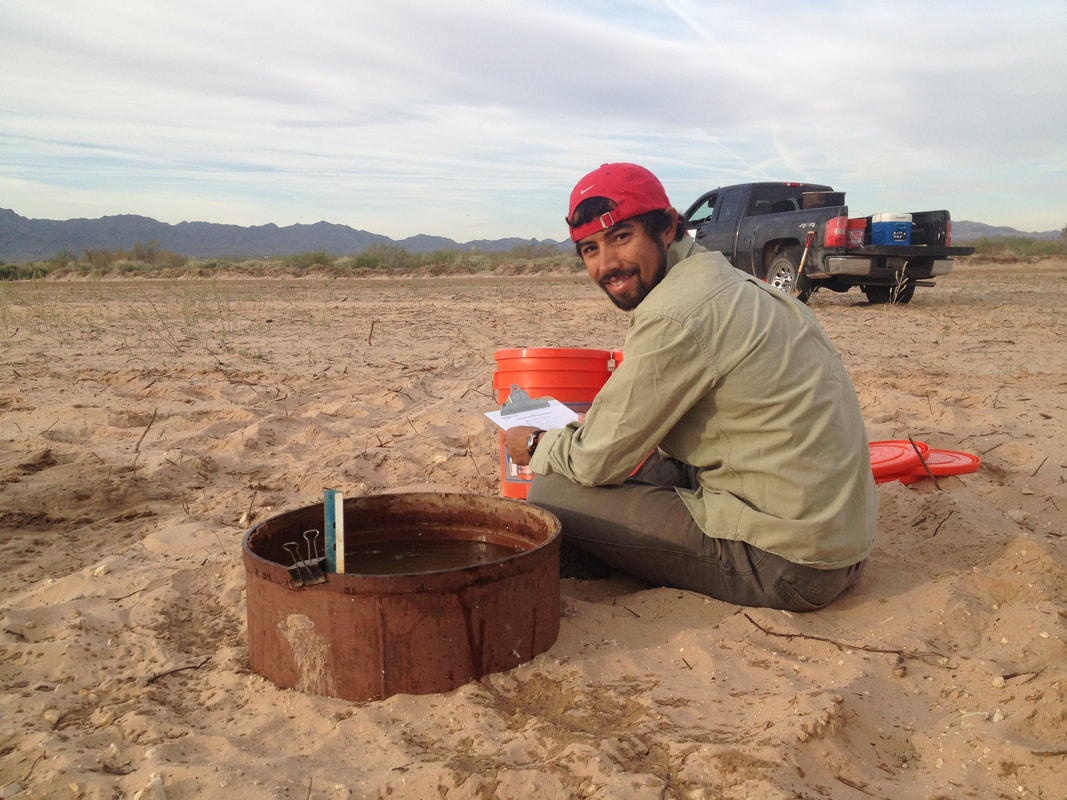What does ecohydrology mean to you?
I have always thought about ecohydrology in the opposing context of how a hydrologist would define hydrology. While a certified hydrologist might improve a flood control project using complex mathematical equations in a world of engineered cement basins and trapezoids, an ecohydrologist might think about recharge basins and how soil and vegetation would impact runoff via infiltration and evapotranspiration (ET). While I couldn’t imagine going the engineering route and conquering the complex courses and math that go hand-in-hand with those degrees, I do get a chuckle when engineers or hydrologists scratch their heads when having to learn about plants and their influence on roughness and ET. That said, ecohydrology is complex in and of itself, and those studying it make contributions that are greatly needed to bridge the gap between the disciplines of hydrology and natural resources.
What are your undergraduate and graduate degrees in?
My undergraduate studies included General Biology with a minor in Wildlife Science. After five years as an entry-level biologist, I returned to school and studied Ecohydrology and Watershed Management (MS, PhD) in the School of Natural Resources and the Environment at the University of Arizona (Go Cats, Bear Down!) within the Papuga Research Lab. I minored in Remote Sensing and Spatial Analysis and acquired a Global Information Systems Certificate along the way.
How did you arrive at working in/thinking about ecohydrology?
Growing up in Lake Havasu, AZ along the Lower Colorado River, I’ve always had an appreciation of water flowing through the desert. Grad school reaffirmed how important riparian corridors are in dryland systems. Half of my dissertation was in applied restoration where I evaluated competition of cottonwood, willow, and tamarisk growth under different irrigation regimes. The other half involved correlating ET flux tower data to remote sensing products to scale ET estimates across vegetation gradients. Both required knowledge of how and why water moves from the earth’s surface to the atmosphere. The easiest way for me to understand the hydrological cycle was to imagine that rain only has a few options after it reaches the surface: it goes up (ET), down (infiltration/storage), or sideways (runoff). The majority of my research looked into how moisture went back up into the atmosphere. By partitioning my research into that bucket, I could then begin to understand how (E)vaporation─direct return of water to the atmosphere from the ground, canopy, or surface water─and (T)ranspiration─water moving from the soil through a plant as the conduit and back to the atmosphere via stomata─really work. Sure there are species-specific implications with overall canopy cover, leaf area, age, salinity tolerance, soil moisture availability, etc, but you just take it one step at a time, and answer one question at a time.
What do you see as an important emerging area of ecohydrology?
For years, the water balance has been difficult to resolve due to high spatial heterogeneity in soils, vegetation, and climate patterns across regions. The evolution of remote sensing products and increased availability and accessibility to multispectral imagery of higher spatial and temporal resolution has resulted in an explosion of applications relevant to managing and monitoring natural resources. Modeled precipitation data has come a long way and an increased network of precipitation gages and long-term datasets allow for higher calibration across ecosystems. Combined, data availability and increased computing power has opened the door for modeling and studying ecohydrological patterns at larger scales to inform water budgets, address human needs, but most importantly in our field, to assess impacts to natural resources; with an aim to preserve, conserve, enhance, rehabilitate, or restore our natural ecosystems for the benefit of native fish and wildlife.
Do you have a favorite ecohydrology paper? Describe/explain.
Nope, I’ll have to simply give a shout out to another graduate committee member, Pamela Nagler (USGS), who has an onslaught of journal articles focusing on plant/water-use relationships; several of which use remote sensing to evaluate water loss or water savings in the context of tamarisk control/invasive species management, riparian revegetation, or restoration monitoring.
What do you do for fun (apart from ecohydrology)?
My years of trail running have given way to mountain biking. I can cover more distance while identifying more plants, birds, and other critters along the way; all while staying vertical. My wife Lindsey and I have an amazing 3-yr old toddler who demands most of our time, especially while sheltering-in-place and practicing social distancing during this Covid-19 pandemic. When the dust settles, we will get back outdoors to camp, hike, and enjoy as much nature as possible!

 RSS Feed
RSS Feed